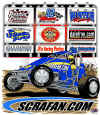DENVER, CO (Jan 25, 2002) - If anybody would have asked a
typical race fan in 1999 just how devastating the next two years of racing would
be, there is no way that he would have predicted the string of tragedy that the
top level of our sport endured during the 2000, and 2001 racing seasons.
The truth is, over 57% of racing deaths over the past 10 years have occurred on
small ovals, taking the lives of 153 hometown heroes. Sadly, these many
local tragedies don't impact safety standards, and development, as forcefully as
higher profile losses.
Dave Skeen, a racer from Colorado, is trying to change this trend with an
innovative new track warning system called Audible Alert. During his 20
years in racing Dave has built, repaired, raced, and taught in the racing
industry. After seeing countless dangerous secondary accidents and witnessing
the near death of Michael Andretti at PIR during a yellow condition, he set out
to find a better way to alert drivers to flag conditions. He was determined to
provide a non-intrusive and cost effective system that could be used by all
levels of racing to reduce accidents before they occur. Invader Technologies,
Inc., was created to take the Audible Alert system and get the racing industry
to "listen up", literally!
The Audible Alert system is the first ever-sound based track warning system.
Using the latest wireless technology with small receivers in each car, an
audible alert tone is used to notify every driver of hazardous track
conditions at exactly the same time. The system also sends each driver an
audible signal when the track goes green to drastically improve starts and
re-starts. The main flagger or track official controls the signals to ensure
everyone gets the proper alert each time. "It's like having the same
spotter for every driver on the track. Unlike radios, all of the drivers receive
the same benefit without any opportunity for abuse or advantage" explains
Skeen.
The Audible Alert system cannot absorb the energy of an extreme impact with the
wall, nor can it save a driver from his worst fear, fire, but rather, the
Audible Alert saves the driver in more ways than one.
Think of Audible Alert as preventative maintenance, the ability to stop
unnecessary racing accidents from even occurring. Accidents that occur as
a result of hazardous track conditions are the most frustrating for racers.
Besides the risk of injury, these accidents also cost them time, money, and
ultimately valuable championship points. It is not uncommon for racing
action to be so intense that the track's yellow warning lights, and the
yellow flag, go unnoticed. In some cases, yellow warning lights are in
disrepair, or are sparsely placed around the perimeter of the track, making it
impossible for a driver to know that trouble is literally just around the
corner.
Given that many tracks are relying on the same lighting equipment they did 30
years ago, and the fact that drivers are visually flooded during race
conditions, the Audible Alert system is timely, and on target. Audible Alert was
put to the test at Colorado National Speedway, a premier NASCAR Weekly track, in
the super stock division, where it passed all tests with flying-colors. "To
watch and hear the entire field check-up and slow down at
the same time after a caution is something I have never witnessed before in all
my years of racing." says Skeen.
In 2000 the super stocks were the worst division for accident rates with many
large secondary accidents that wiped out many cars. There were several wrecks
that occurred during re-starts. Due to the high number of wrecks, about half of
their races were called off after finishing only 10-12 laps due to time
constraints.
In 2001, using only the Audible Alert System, they were by far the best division
with no big secondary wrecks, easily outperforming even the Late Model division
that runs radios with multiple spotters. All of the starts and re-starts went
very smoothly with no wrecks since everyone was aware of the green at the same
time. Almost all of the cars finished every race resulting in the highest car
counts at the track. All of the races were completed on time with most 30-lap
races done in 30 minutes. As a result the Super Stock division is going to
receive more races and laps in 2002.
While the current version in use today is designed for ovals or full course
notification for road courses, changes are coming in future versions to make
even more improvements. GPS will be added to the receiver units to allow for a
localized yellow at every turn on a road course. This will not only improve
safety for the drivers, but will also reduce injuries to corner workers.
Allowing the corner worker to trigger a caution while situated in a safe
location far away from the track action can eliminate the need to expose them to
a potential dangerous situation close to the track. This GPS version will also
allow for instant car alignment at the exact time a yellow is initiated. This
will eliminate the dangerous practice of racing through the yellow or the
lengthy time to go back to the previous lap.
With a common sense approach, Skeen and his company Invader Technologies is
aggressively marketing the Audible Alert system among the ranks of racetrack
promoters and sanctioning bodies. If they can get the ear of racing's
decision makers, they will get the ear of the driver, reducing the cost of
racing in more ways than one, and improving the quality of racing for fans.
For more information please visit www.invadertech.com.



